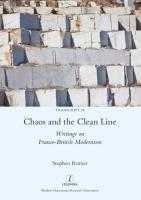
An interview with Stephen Romer
Congratulations on the publication of your book. Can you tell us a little about its contents?
Thank you very much! Chaos and the Clean Line: Writings on Franco-British Modernism is in fact an ingathering of book chapters, essays and reviews written over a period of nearly three decades. The scope of the book is fairly vast, starting with Baudelaire and Nerval and going all the way through to two late Modernists, Yves Bonnefoy and Geoffrey Hill, who died within 24 hours of each other in 2016. The word ‘writings’ is germane in the sense that the pieces are of varying length and genre – there are concentrated overviews, say of the French Decadent movement in literature, or of T.S. Eliot’s lifelong interest in French poetry. Then there are pieces that focus more narrowly, for example on the poet Pierre Reverdy (I analyse at length a single poem) or the prose poems of Paul Valéry. Other, shorter pieces were written in response to occasions – the 200th anniversary of Baudelaire, the centenary of Mallarmé’s death, ditto of Proust’s, or much nearer our own time, an obituary of Geoffrey Hill. Initially hesitant about the form or unity of the book, in editing it I have gained confidence that the pieces do in fact talk between themselves, so to speak, and that sometimes a short, sharp, and one hopes trenchant appraisal can stand in fruitful counterpoint to the longer analyses I have mentioned.
Who are some of the major figures you mention in your essays?
I have mentioned some already: Baudelaire, Gérard de Nerval, Verlaine, Mallarmé, Rimbaud, Jules Laforgue and Tristan Corbière. Maupassant, J.-K. Huysmans, Octave Mirbeau, Léon Bloy and others are all touched upon in the long overview of French Decadence considered as a literary movement. Several pieces are devoted to Apollinaire and his very particular type of war poetry, so different in kind to the consecrated War Poets as we know them in Britain. One piece compares Apollinaire, and the response to the First War of European Modernism more generally (Marinetti et al.) with the figure of Wilfred Owen. There are two large sections, the first called ‘Eliot in Purgatory’, the second ‘Pound and Paradise’, though I am of course aware both these figures were originally American, but they took up residence in England and Europe and stayed there. Nearer our own time, there are essays devoted to poets like Yves Bonnefoy, Geoffrey Hill or Louise Glück.
Can you give a quick definition of literary modernism for non-specialists?
Ha! That is very difficult, because literary modernism is by nature multifarious and sometimes contradictory. For example, Ezra Pound dreamed of an ‘imaginary museum’ (to adopt a phrase coined by André Malraux) in which the best poetry (or art) of all periods should be available and considered (judged) according to a similar scale – Eliot refined on this by suggesting that the canonical works of art comprise a simultaneous order, and the addition of the ‘really new’ work, changes that order, the new work altering our perception of every past work (certainly this is an effect of his masterpiece The Waste Land). In violent contrast, a flamboyant figure like Marinetti, the founder of Italian Futurism, proclaimed the supremacy of the machine and called for the destruction of libraries and galleries that in his view weighted down upon the dynamic present. I suppose both attitudes involve a self-consciousness concerning the place and the purpose of the work of art in a way that has rarely been subjected to such analysis, a trend that really began when Baudelaire, at the well-head of Modernism, declared that the poem should serve only itself, and not have moral or theological or didactic designs upon the reader. That is a brief (very brief) account, there is obviously a great deal more to say (and I hope I develop some of these strands in my book).
What links do you perceive between French and English-language writers in the period you study?
That again is a question that would take me far and wide. Again, if I may take just one example, that of T.S. Eliot, whose engagement with French poetry lasted a lifetime: Jules Laforgue provided him with a ‘mask’, that of the clown-like, melancholic Pierrot to speak through; Corbière gave him a spiky, ironical, early style, and Théophile Gautier taught him to be lapidary, trenchant, aphoristic Later, the Symbolist Mallarmé, and his disciple Valéry deeply influenced Eliot’s thought about such crucial formal maters as poetry and musical structure, what is poetic language, and how far should it be removed from everyday speech, if at all; the relation between poetry and theology, between the word and the Word. In different doses and with different emphases, these questions inform nearly every poet, either French or English, who came to examine the practices of his or her neighbour across the channel.
You are a poet and translator yourself. How does your practice inform your research?
Briefly, I should say that my practice as a poet informs my engagement with certain poets and poems; there is perhaps a ‘drama of projection’ that I am aware of playing out, particularly in my multiple response to Eliot, perhaps, and his vicissitudes – or with Nerval and Laforgue who had ‘difficulties with girls’ shall we say! There is (I hope) a particular engagement and added intensity if one practices the art oneself (but inversely it may cause partiality and blindness…)
You have taught English in France and you are a lecturer in French at Brasenose. What do you enjoy most about undergraduate teaching in Oxford?
My college-based undergraduate teaching, mostly in the field of unseen translation, has been and continues to be an unalloyed joy. Translation is by its nature, and necessarily, a shared activity, when one teaches it. The groups are small, which is one of the huge privileges enjoyed by Oxford students and dons alike, so the quality of the exchange is always enhanced.